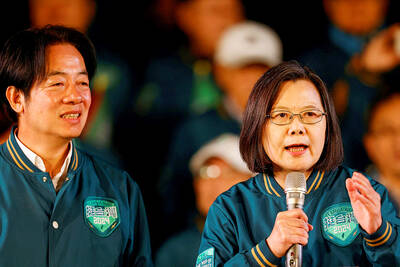Wu Tung-lung (吳東龍) would rather hear about his works than talk about them. Even quoting other people, he doesn’t say much.
“Some people think my paintings describe a feeling, like a feeling they had a long time ago … Other people see animals,” he says, slowly sipping from a straw at a coffee franchise in Taipei.
Just back from a six-month residency at Cite Internationale des Arts in Paris, the somewhat reticent 32-year-old painter will be showing 14 of his most recent works at VT Art Salon (非常廟藝文空間) beginning on Saturday.
Wu hopes the show will attract attention to paintings that exude “tradition” and “elegance.”
It probably will. Big-seller Impressions Gallery (印象畫廊) has been exhibiting Wu’s work recently and his older brother, Wu Dar-kuen (吳達坤), is one of eight established Taiwanese artists who opened VT, the bar-cum-gallery that will host his largest solo exhibition to date.
Though born and raised in Taipei, Wu developed his current style while a graduate student at Tainan National University of the Arts (國立台南藝術大學) six years ago. After years of obediently learning the realism advanced by his junior high, high school and undergraduate instructors, the secluded campus and relaxed atmosphere in Tainan allowed him more time to think for himself, and he gladly abandoned the formalist style he’d developed up to then.
“I thought about which parts I didn’t need, and if I didn’t need something, I deleted it. What was left was what I really, really needed. And it’s this.”
Life in Tainan didn’t “delete” Wu’s metropolitan flavor. Muted regal colors and simple, enigmatic patterns meet in works that seem carefully designed to hang well in an affluent Taipei East District living room. The pieces are unobtrusive and unapologetically decorative. They almost seem therapeutic.
To his credit, Wu doesn’t shy away from listing artists he admires: Mark Rothko, Frank Stella, Cy Twombly. All three now elderly or dead Americans, their works are famous for requiring time to appreciate. Museums have been criticized for showing Rothkos without a bench on which to rest and appreciate them from.
Wu’s paintings ask for a similar contemplation, as does the artist himself. He speaks with a grandfatherly patience when discussing his paintings.
“I like to spend time with my works, not [only] to make them, but in the studio or gallery,” he says, composing himself between sentences. “I try to pretend I’m not a painter … I try to feel them.”
For people who can’t afford to own one of Wu’s paintings, his show at VT might be their best option. Comfortable seats and drinks are available at the adjoining bar, and aside from weekends there usually aren’t crowds to keep you from dragging a chair into the gallery to sit and ponder what’s beneath the surface of these seemingly simplistic paintings.
There may be more there than one might think.
“I’m a very emotional person,” Wu says.

Last week Joseph Nye, the well-known China scholar, wrote on the Australian Strategic Policy Institute’s website about how war over Taiwan might be averted. He noted that years ago he was on a team that met with then-president Chen Shui-bian (陳水扁), “whose previous ‘unofficial’ visit to the US had caused a crisis in which China fired missiles into the sea and the US deployed carriers off the coast of Taiwan.” Yes, that’s right, mighty Chen caused that crisis all by himself. Neither the US nor the People’s Republic of China (PRC) exercised any agency. Nye then nostalgically invoked the comical specter

Over the course of former President Ma Ying-jeou’s (馬英九) 11-day trip to China that included a meeting with Chinese Communist Party (CCP) leader Xi Jinping (習近平) a surprising number of people commented that the former president was now “irrelevant.” Upon reflection, it became apparent that these comments were coming from pro-Taiwan, pan-green supporters and they were expressing what they hoped was the case, rather than the reality. Ma’s ideology is so pro-China (read: deep blue) and controversial that many in his own Chinese Nationalist Party (KMT) hope he retires quickly, or at least refrains from speaking on some subjects. Regardless

Approaching her mid-30s, Xiong Yidan reckons that most of her friends are on to their second or even third babies. But Xiong has more than a dozen. There is Lucky, the street dog from Bangkok who jumped into a taxi with her and never left. There is Sophie and Ben, sibling geese, who honk from morning to night. Boop and Pan, both goats, are romantically involved. Dumpling the hedgehog enjoys a belly rub from time to time. The list goes on. Xiong nurtures her brood from her 8,000 square meter farm in Chiang Dao, a mountainous district in northern Thailand’s

Peter Brighton was amazed when he found the giant jackfruit. He had been watching it grow on his farm in far north Queensland, and when it came time to pick it from the tree, it was so heavy it needed two people to do the job. “I was surprised when we cut it off and felt how heavy it was,” he says. “I grabbed it and my wife cut it — couldn’t do it by myself, it took two of us.” Weighing in at 45 kilograms, it is the heaviest jackfruit that Brighton has ever grown on his tropical fruit farm, located